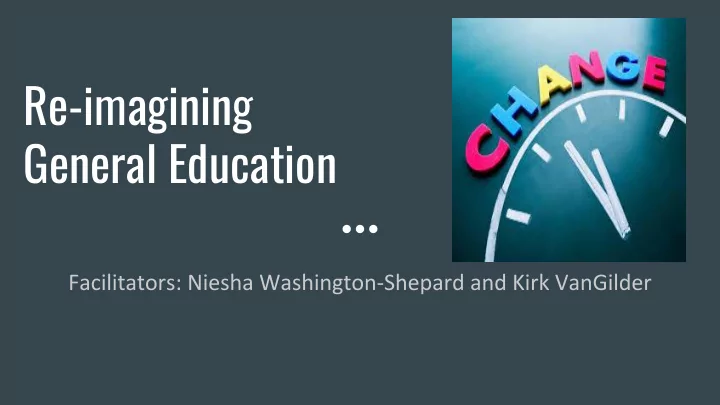

Re-imagining General Education
Why re-imagine?: Keeping it Student Centered Consider your students as you think about curriculum: Intersectionality - How do 21st century students understand ● themselves and their world? Digital - How do they access information? ● Interdisciplinary - How do they connect information to ● create knowledge? Citizenship - How do they use knowledge to develop wisdom? ● Career readiness and Passion - What engages them, keeps ● their focus, and drives their career journey?
Why re-imagine?: Social Justice in the Classroom Making positive change in the world Connecting with students ● Discussing Real-world problems and ● multiple perspectives Creating classroom community ● Including authentic assessments ●
Summer Team Roster Gregoire Youbara (WLC) Niesha Washington-Shepard (co-facilitator) (ASL/DST) Bobbie Jo Kite (EDU) Kirk VanGilder (co-facilitator) (HPRS) Ryan Maliszewski (GIEI) Tawny Holmes Hlibok (consultant) (ASL/DST) Michelle Burke (STM) Leslie Rach (GSR Program Director, 230 Coordinator) Resource support: Kathy Wood (GSR 101, 150 Coordinator) (ENG) Lindsay Buchko (Institutional Research) Tonya Stremlau (GSR 102 coordinator) (ENG) Tommy Horejes (SSAQ) Richard Cornish (GSR 103 coordinator) (ASL/DST) Jerri Lyn Dorminy (Student Success) Susanna Henderson (GSR 104 coordinator) (STM) Paige Franklin (Assistant Dean, UG Curriculum) Jane Nickerson (GSR 210, 300 coordinator) (ENG) Tami Santimyer (Recruiting) David Barclay (GSR 220 coordinator) (SWK) Laura Willey-Saunders (Admissions) Caroline Solomon (STM, IZN committee)
Sources ● GSR Self Study ● External reviewers ● Student focus groups ● AAC&U guidelines and materials ● Articles and research on general education trends ● General Education design at other institutions ● Gallup sponsored conference on higher education
Links to Resources The summer group report and updates are available on a website under the Student Success and Academic Quality website. This site will be updated through the process. https://www.gallaudet.edu/student-success-and-academic-quality/gene ral-education-redesign
The three proto-models Adaptation model - seeks to meet the needs of 21st century students by building on strengths and adapting weaknesses of our current general education curriculum. Hybrid model - seeks to build a broadly shared curriculum path that connects general education to student majors and minors. Pathways model - seeks to be flexible and customizable to tailor to specific types of students we encounter.
What do the models have in common Similar Student Learning Outcomes that incorporate innovation, digital literacy, ● bilingualism, career development, global citizenship, and social justice into our current cluster of outcomes A first semester focused on foundational skills in ASL, English, and Math ● Department ownership of courses with course approval oversight by a faculty council ● Retention of our Student Success units (Jumpstart, Peer mentoring, tutoring, etc.) ● An oversight that needs correcting to include health and wellness outcomes ●
What makes the adaptation model unique? ● Combines some of our current SLOs and implements two new SLOs of digital literacy and innovation. ● Reduces the number of credits required for general education creating more room for student electives, double majors, and minors. ● SLOs can be completed across both general education course and courses within one’s major field of study.
What makes the hybrid model unique? First Year Seminar becomes a ‘sampler’ of disciplinary approaches to a common Big ● Question Presumes two 3 credit courses on the average for ASL, English, and Math ● The Ethics course and Social justice/Citizenship course are taught using case studies ● developed by students from their major field of study Gallaudet That! sequence integrates classroom learning with career goals ● Capstone course is integrated into student majors ● Gated four year plan of development of skills (years 2 and 3 might be intermixed) ●
What makes the pathways model unique? Implementation at first will seem fairly similar to what we have now, but can become more ● tailored to student needs as we commit to gathering better data on our students and develop more adaptive learning strategies Two staged plan for foundational skills followed by advanced skills. Could be completed in two ● semesters if a student is well prepared for college, or extended through one’s college career First year seminar course takes place within one’s academic cluster to build a cohort of ● similarly interested students. Bison Hoofprint allows students to choose a high impact experience to make their mark on ● their educational experience.
Developments since the summer workshops Freaky Fun Friday General Education Redesign Workshops every Friday from 11-2 as ● open collaborative community gatherings. Proposal to Faculty Senate to establish an ad hoc Council on General Education to ● oversee design decisions, clarify duties for a permanent council and directors, communication and lobby for resource allocation and generation for General Education needs. Proposed Student Learning Outcomes and emerging structural model built ofg the ● Pathways Model but incorporating some elements from the others.
Second Draft of Proposed Student Learning Outcomes As a Gallaudet Scholar, my General Education will equip me to: 1. Be a bilingual communicator in ASL and written 5. Understand the natural world through scientific English in a diverse and multilingual world. methods. 2. Understand intersectional identities, articulating my 6. Make ethical judgments and act with wisdom. own experience and respecting the experiences of 7. Use digital information technology efgectively and others. responsibly. 3. Engage a complex world as a responsible global 8. Be intentional in understanding and cultivating my citizen in collaboration with others. health and well-being. 4. Be a critical thinker who connects varied information to solve problems in innovative ways.
Questions that guide our community discussions: ● Which of the three models best prepares 21st Century Gallaudet students for success? Give your reasons. ● Which of the elements do you see in the models that most excite you? ● After reviewing the three models, what elements do you think pose the most challenge? Give your reasons. ● Are there aspects of General Education that the models have overlooked?
Recommend
More recommend